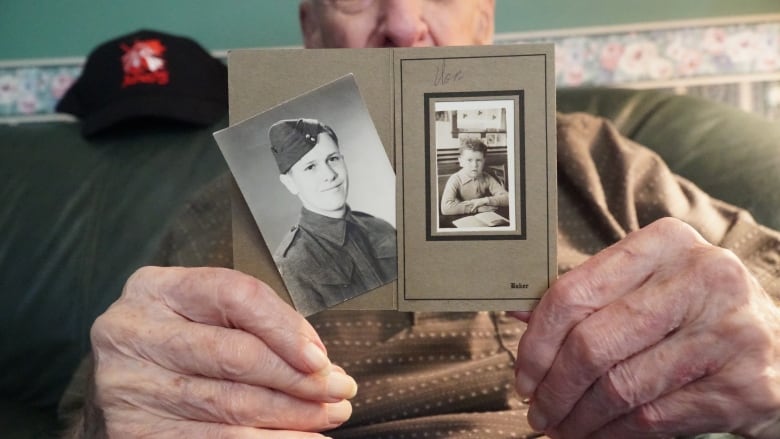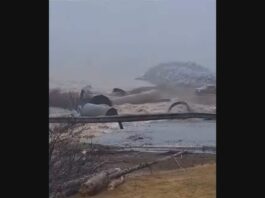
Fred Barnard landed on Juno Beach as part of the Queen’s Own Rifles regiment on June 6, 1944, along with his younger brother, Donald, who was killed after reaching shore. (Laura Clementson/CBC)
On the morning of June 6, 1944, Fred Barnard and one of his younger brothers, Donald, were together on the same assault landing craft, bracing themselves for the attack on Juno Beach in France.
Both were members of the Queen’s Own Rifles, a primary army reserve infantry regiment based out of Toronto, with Fred holding the rank of corporal and Donald a rifleman at the time.
Moments before disembarking into the choppy waters with their platoon, Fred said: “Give ’em hell, Don.”
It was the last time Fred ever spoke with his little brother.
Once Fred reached the shore, he found Donald lying dead on his back. It seemed clear to him that his brother had been killed instantly by enemy fire.
But with a crucial objective for the Allied forces at stake, Fred had to carry on with the mission. He couldn’t stop for anything.
“I was his brother, and it was something to see him,” Fred said. “He never made it to the wall.”
Fred holds up photos of his brother, whose story is being shared by way of a postcard mailed to the Barnards’ former home in Toronto, a project initiated by the Juno Beach Centre Association. (Laura Clementson/CBC)
Donald was one of 359 Canadians killed on the first day of the invasion of Normandy, known as D-Day — a military campaign that has gone down in history as the beginning of the end of the Second World War.
Another 544 Canadians were killed over the next four days of intense fighting in France.
To commemorate their sacrifice, the Juno Beach Centre Association (JBCA), a charity based in Burlington. Ont., that operates a museum and cultural centre in Normandy devoted to Canada’s Second World War history, has sent postcards to the last known Canadian addresses of the fallen soldiers.
Linking past to present
The postcards were mailed from Toronto at the beginning of May. The front of each postcard shows a collage of images from the landing. On the back is information about the soldier who used to live at the address, including age, regiment, rank and a few details about the soldier’s death on the battlefield in France.

The image that appears on the front of the postcard depicting scenes from the storming of Juno Beach in France on June 6, 1944. ( Juno Beach Centre Association)

The back of the postcard lists information about the soldier who used to live at the address the postcard is mailed to, including age, regiment, rank and details of his death on the battlefield. (Laura Clementson/CBC)
It’s a way to link the past and present and commemorate the soldiers, said Lisa Murray, a JBCA volunteer in Toronto who organized the project.
Her hope is that people will be inspired to learn about the soldier who once lived at their address and to share their thoughts about receiving the postcard with the JBCA and on social media.
“We thought this is a way to sort of have this as a living memory and to honour them,” she said.
In a sense, the cards represent the postcards that the soldiers never had an opportunity to send home, she said.

The postcards represent those the soldiers they commemorate never got to send home, says Lisa Murray of the Juno Beach Centre Association. (Laura Clementson/CBC)
Hundreds of postcards across Canada
With changing landscapes and re-development over the past 75 years, not all 903 homes are still standing. A total of 356 postcards found their way to homes across the country — with some receiving more than one.
A home on Sutherland Avenue in Toronto’s east end received Donald’s postcard. The homeowner would have learned that Donald was a rifleman and was 20 years old when he died.
He was buried at Bény-sur-Mer, a Canadian war cemetery in Reviers, France.
The Barnard brothers lived at the house on Sutherland Avenue before they enlisted. When shown a photo of what the house looks like now, Fred noticed that it’s much bigger, with the addition of a second floor.
‘We were one’
One of his fondest memories growing up on the street was watching the 10:15 p.m. train at Victoria Park and Danforth Ave.
“That was our fun for the night.”
Fred said he and Donald hung out with different groups of friends when they were kids.
“But when we got in the army, we were one.”
Shortly after returning to Canada in 1945, Fred bought the property next to his parents on Sutherland and built a home where he raised his family.
Fred, who at 98 is the oldest surviving D-Day veteran of the Queen’s Own Rifles, now lives in Uxbridge Ont., about 70 km northeast of Toronto, with his daughter, Donna, and two golden retrievers — one fittingly named Juno.
He also has a son, Donald. Both children were named in honour of his late brother.
When Fred saw the image on the front of the postcard depicting lots of action on the beach, his first thought was that it must have been taken after he and his platoon arrived.
“There was nobody … we were the first ones in as far as I’m concerned,” he said. “The first bunch.”
Donna Barnard says her father only opened up about the war in the last 15 years or so. (Laura Clementson/CBC)
‘Dad never talked’
Donna Barnard says her father didn’t talk much about her uncle growing up.
“We sort of were told that we had another uncle who was killed in the war, but my dad never talked about anything to do with the war,” she said.
It’s only been in the past 15 years or so that she began to learn the odd detail about her family’s involvement in the war.
Slowly, Fred started to open up not only to her but to others, happy to share his story for the postcard project.
“It gives me a warm feeling that they’re remembering them all in the hope that all Canadians will learn this, and understand what really happened out there, how many young men we really did lose,” Donna said of the initiative.
D-Day vet ‘walked the same floorboards’
Susan Wilson of Toronto initially thought she had received junk mail when a postcard arrived in the mail. But when she realized that it was about Arthur Bray Barret, a 25-year-old private with the North Nova Scotia Highlanders, she says she was “quite stunned.”
“It was very moving that this young man was brought to my attention,” she said.
“He once walked the same floorboards.”
Wilson, 71, says the postcard resonates with her because she, too, had family members in the war.
The Juno postcards are just the beginning of the Juno Beach Centre Association’s larger initiative to commemorate soldiers who were killed in action during the Second World War.
They’ll be sending out more postcards marking other Canadian milestones that occurred between D-Day and the end of the war in May 1945.
As for Fred Barnard, he’s a local hero in Uxbridge. To honour him and his brother, the community is hosting a parade on June 6 that will start from Fred’s front lawn.












